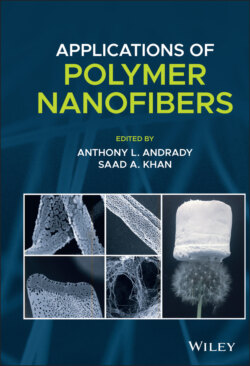Читать книгу Applications of Polymer Nanofibers - Группа авторов - Страница 2
Table of Contents
Оглавление1 Cover
2 Title Page
3 Copyright Page
4 Dedication Page
5 List of Contributors
6 Prefacepreface
7 1 Electrospinning Parameters and Resulting Nanofiber Characteristics 1.1 Electrospinning Overview 1.2 Effect of Process Parameters 1.3 Effect of Setup Parameters 1.4 Effect of Solution Parameters 1.5 Electrospinnable Systems 1.6 Advanced Fiber Characteristics 1.7 Process Scalability References
8 2 Textile Applications of Nanofibers 2.1 Introduction of Nanofibers in Textile Applications 2.2 Fabrication of Nanofiber Yarns 2.3 Structure and Properties of Nanofiber Yarns 2.4 Fabrication of Nanofiber Fabrics 2.5 Characteristics and Specialized Applications of Nanofiber Fabrics 2.6 Summary and Future Trends References
9 3 Nanofiber Mats as High‐Efficiency Filters 3.1 Introduction 3.2 Filters Made with Nanofibers 3.3 Filtration Developments 3.4 Outlook Acknowledgments References
10 4 Nanofiber‐Based Chemical Sensors 4.1 Introduction 4.2 General Features of Sensors 4.3 Nanofibers as a Sensor Material 4.4 Approaches to Nanofiber Sensor Design 4.5 Gravimetric Nanofiber Sensors 4.6 Optical Sensors 4.7 Electrochemical Sensors References
11 5 Nanofibers in Energy Applications 5.1 Overview 5.2 Energy Storage Applications 5.3 Energy Conversion Applications 5.4 Concluding Remarks References
12 6 Electrospun Nanofibers for Drug Delivery Applications 6.1 Introduction 6.2 Methods for Encapsulation of Bioactive Molecules in Electrospun Nanofibers 6.3 Conclusion References
13 7 Interfacing Electrospun Nanofibers with Microorganisms: Applications from Killing to Repelling to Delivering Living Microbes 7.1 Introduction 7.2 Brief Background on the Electrospinning Process 7.3 Electrospinning Process and Variables 7.4 Why It Is Important to Understand the Interactions Between Biomaterials and Microorganisms 7.5 Background on Antibacterial Surface Engineering 7.6 Background on Antifouling Surface Engineering 7.7 Polymer Selection for Nanofibrous Biomaterials 7.8 Electrospinning Techniques Tailor the Location of Active Agents 7.9 Blend Electrospinning Yields a Dispersed Active Agent 7.10 Coaxial and Emulsion Electrospinning Enables the Controlled Delivery of Active Agents 7.11 Coating Electrospun Mats Tailors Their Interactions with Cells 7.12 Antibacterial Nanofiber Mats 7.13 Multifaceted Delivery from Nanofibrous Mats 7.14 Antifouling Nanofiber Mats 7.15 Nanofibrous Mats Containing Living Cells 7.16 Conclusion Acknowledgments References
14 8 Advances in Functionalizing the Interior and Exterior of Polymer Nanofibers 8.1 Introduction 8.2 Nanofibers with Controlled Nanoparticle Distribution 8.3 As‐spun Nanofibers with Bioresponsive Properties 8.4 Polymer Nanofibers with Postfunctionalized Surfaces 8.5 Nanofibers Produced by Directed Self‐Assembly 8.6 Concluding Remarks Acknowledgments References
15 9 Nanofiber Aerogels 9.1 Aerogels 9.2 Nanofiber‐Based Aerogels 9.3 Future Perspectives References
16 10 Micro and Nanofibers 10.1 Electrospinning 10.2 The Melt‐blowing Process 10.3 “Splittable” Bicomponent Fibers 10.4 Partially “Soluble” Bicomponent Fibers 10.5 Fibrillating Bicomponent Fibers References
17 Index
18 End User License Agreement
